
![]()
Search the Journey to Forever website – click HERE
|
Journey to Forever: Make a donation |
En español
Biocombustibles, biodiesel
Navigation
Contact usTo Keith Addison Handmade Projects |
Foolproof
pictures
Aleks made a couple of mini-batches in glass jars for these photographs -- one batch of heavily used cooking oil and fat, and one of pure fat.
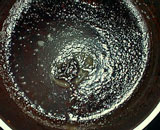
1. 30% fats and 70% oil -- lumps of semi-hard fat remain after water boil-off.
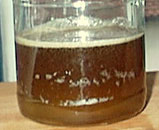
2. Fat-oil mixture after melting.
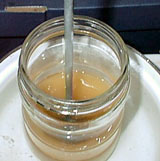
3. Suspension formation after methanol introduction (note murkiness).
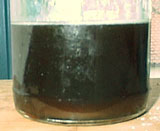
4. End of acid stage (note darker colour).
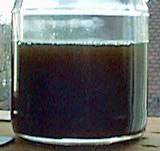
5. 100% semi-solid fats-melted fats.
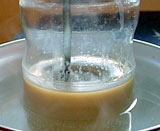
6. Change after adding methanol: murky fat (normal -- this is procedure).
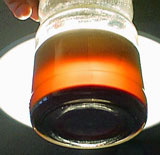
7. First-stage glycerine.
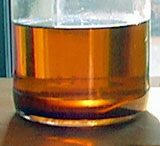
8. Second stage -- finished esters.
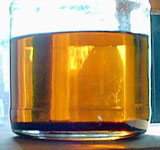
9. Second-stage glycerine.
The FOOLPROOF way to make biodiesel
By Aleks Kac
In two professional biodiesel fuel analyses, two years apart, home-brewed biodiesel made by this method met the German DIN 51606 biodiesel standards. This means the fuel is suitable for warranty repair by VW for all their vehicles made from 1996 till today. You can make DIN and ASTM-compliant fuel just by carefully following the instructions. See National standards for biodiesel
Free fatty acid to ester conversion
Spanish version – Versión en español
NOTE: The two-stage biodiesel processes are advanced methods, not for beginners – learn the basics thoroughly first. The single-stage base method is the place to start.
Start here.
This is a FOOLPROOF way to make biodiesel. No titration is required, and no extra equipment or special equipment -- a thermometer's handy, but NO pH meter!
This is a two-stage procedure, acid first-stage, base second-stage. It is based on the highest free fatty acid (FFA) content found in used cooking oil, but it can be used with any waste vegetable/animal oil or fat, whether or not it has a high FFA content. The process increases yields dramatically. Use it as your standard method.
Introduction
To make biodiesel fuel efficiently from used vegetable oils and animal fats we have to avoid one major problem: soap formation. Soap is formed during base-catalyzed transesterification (using lye) when sodium ions combine with free fatty acids present in used (and some virgin) vegetable oils and animal fats. The soaps diminish the yield because they bond the methyl esters to water. The bonded esters get washed out at the washing stage but make water separation more difficult and increase water consumption. This process takes care of the free fatty acids. You don't need a special processor for the Foolproof method. Generally, a bottom-drained reactor vessel is best, closed on top. Tall, narrow containers work better than wide, shallow ones. Use a circulating pump for mixing rather than a mechanical stirrer. The pump should take the mixture from near the bottom of the reactor and return it via the top, to splash down on the surface. For a 35-litre reactor, a 100-W washing-machine pump will do, along with a 1.5kW washing-machine immersion heater to heat the mixture (get a heater that's coated with stainless steel). You could use a thermostat to control the temperature, but they're expensive: just use a thermometer and switch on the heater as required. Whenever you're trying a new method, it's always a good idea to make small test batches of a litre or less first to familiarize yourself with the process before moving on to bigger batches. Most people use kitchen blenders for this -- but don't use it for food again afterwards! 1. Filter the used cooking oil first as usual. 3. Measure the volume of oil/fats to be processed (preferably in litres). This is the base-catalyzed stage. 19. Use the bubblewash method, but no need to monitor pH anymore. Just add a little 10% phosphoric acid (H3PO4) to the washing water first, 10 millilitres per gallon (2-3 ml/litre), just to be on the safe side -- I don't want ANY lye floating around my fuel pump. A question will probably arise: why not mix the methanol with the sulphuric acid before adding them to the oil/fats? Two major reasons: (a) the reaction between methanol and concentrated H2SO4 is quite violent and it could splash, which doesn't happen if you mix it as described; and (b) dimethyl ether can form. Mixing alcohols with concentrated H2SO4 is a way to dry the alcohols (which is good) and also a way to make di-alcohol ethers, not good: dimethyl ether is a gas, colourless and highly explosive. The second-stage product should be quite murky. This is no problem, as it will wash out. To keep costs down, even amateur biodiesel producers try to salvage the unreacted methanol. There are two major methods to do this: heat extraction and vacuum/heat extraction. Diesel engines require quality fuel. You just can't pour poor-quality biodiesel into the tank and expect the engine to go on and on without problems. You have three very dangerous enemies: free glycerine, poorly converted oils/fats and lye. Free glycerine and mono-, di- and triglycerids (poor ester conversion) will form gum-like deposits around injector tips and valve heads, lye can damage the injector pump. The key to good fuel is to just do it right and finish it! Use pure chemicals (sulphuric acid, sodium lye and methanol) and measure them accurately, and follow the instructions carefully -- this will take care of poor conversion. Proper washing will get rid of the glycerine and neutralize any remaining lye. © Copyright Aleksander Kac, 2001. Patents pending. This is a proprietory process. This material may be copied and distributed for non-commercial education purposes only, as long as the source of the material is stated and a reference to this website URL is included:
In one early test I used a mixture of 50% heavily used cooking oil and 50% pork lard. The result was a pure product with absolutely no trace of soap! The biodiesel looked nice, and smelt nice, as if made from virgin oil.
This is a simple procedure. The first-stage process is not transesterification, but pure and simple ESTERIFICATION. Esterification is followed by transesterification, but under acid conditions it's much slower than under caustic conditions and it won't do a complete oil-to-methyl ester conversion as the reaction is much more equilibrium-sensitive. Without methanol recovery, the alcohol overdose required would make the price of your fuel jump, and even with recovery it would still be much more expensive. Hence the second base-stage.

Aleks (background) and friend Matevz making biodiesel in Matevz's living room.
For the first stage you'll form a compound out of an acid and an alcohol. The alcohol is still methanol, but instead of using lye (sodium hydroxide), the CATALYST in this reaction is sulphuric acid ("battery acid"). It needs 95% sulphuric acid (battery acid is around 50%). Sulphuric acid is one of the commonest chemicals on Earth, just like lye. More concentrated sulphuric acid -- 98% and above -- costs more, but 95% works just fine if you follow these directions. Other acids won't work: it must be sulphuric acid. You can buy sulphuric acid online from Duda's Alternative Energy Store: http://dudadiesel.com/
The second stage uses lye, as usual -- but it only uses about half as much as other methods.
The sulfate ion in the sulphuric acid combines with the sodium ion in the lye during the second-stage reaction to form sodium sulphate, which is a water-soluble salt and is removed in the wash. No sulphur remains in the biodiesel fuel product.
Equipment
Ordinary iron and steel implements and containers will eventually corrode because of the acid used in this process. However, you can still use the usual 55-gal (200-litre) drum. The proportion of acid used in this process is very low -- you should be able to use an uncoated drum for a year or more before the rust gets out of control. I use a polypropylene plastic reaction vessel. Any plastic that won't deform at 100 deg C (212 deg F) or a bit more is fine. Stainless steel is also fine. Use an immersion heater with plastic containers. With steel containers you can use propane heaters to heat the oil, then switch to an immersion heater before adding the methanol.
Sulphuric acid is a DANGEROUS CHEMICAL. Take full safety precautions, wear safety goggles, gloves and apron and eye protection. Have running water nearby. Don't inhale fumes!
If you run out of sulphuric acid NEVER try to make up the required volume with nitric acid. It may form small quantities of nitroG (nitroglycerine) -- even the smallest amount can cause horrible accidents. See: High Explosives
Methanol can cause blindness and death, and it is absorbed through the skin. Sodium hydroxide can cause severe burns and death. Together these two chemicals form sodium methoxide. This is an extremely caustic chemical. These are dangerous chemicals -- treat them as such! Always have water running nearby when working with them. The workspace must be thoroughly ventilated. No children or pets allowed. Wear safety goggles, gloves and apron and eye protection. Do not inhale any vapors. See Safety for further information.Test batches
The process
2. For a successful reaction the oil must be free of water. Here are two methods of removing the water content:
(a) Settling the water out: This method saves energy. Heat the oil to 60 deg C (140 deg F), maintain the temperature for 15 minutes and then pour the oil into a settling tank. Let it settle for at least 24 hours. Make sure you never empty the settling vessel more than 90%.
(b) Boiling the water off: Less-preferred method as it uses more energy and helps to form more FFAs in the oil. Heat the oil to 100 deg C (212 deg F). As the heat rises water separates out and falls to the bottom -- drain it off to avoid steam explosions. Maintain the temperature until no more steam bubbles rise.First stage
4. Heat the oil to 35 deg C (95 deg F) -- make sure that all solid fats are melted.
5. Methanol: use only 99%+ pure methanol. Measure out the methanol -- 0.08 litres of methanol for each litre of oil/fats (8% by volume). Add the methanol to the heated oil.
6. Mix for five minutes -- the mixture will become murky because of solvent change (methanol is a polar compound, oil is strongly non-polar; a suspension will form).
7. For each litre of oil/fats add 1 millilitre of 95% sulphuric acid (H2SO4). Use a graduated eyedropper, a graduated syringe or a pipette. TAKE CARE when handling the concentrated sulphuric acid!
8. Mix gently at LOW rpm (don't splash!) while keeping the temperature at 35 deg C. The rotation of your stirrer should not exceed 500 to 600 rpm -- speed is not crucial and splashed oil is a mess to clean.
9. Maintain the temperature at 35 deg C for one hour then stop heating. Continue stirring.
10. Stir the unheated mixture for another hour, a total of two hours, then stop mixing. Let the mixture sit for at least eight hours, overnight is better.
11. In the meantime prepare the sodium methoxide: measure 0.12 litre of methanol for each litre of oil/fat (12% by volume) and weigh 3.1 grams (up to 3.5 grams if purity is in doubt) of sodium lye (sodium hydroxide, NaOH) per litre of oil/fat. Mix the lye into the methanol until the lye is completely dissolved.
Sodium methoxide is a DANGEROUS CHEMICAL. Take full safety precautions when working with methanol, lye and sodium methoxide, wear safety goggles, protective gloves and clothing, have running water nearby.
NOTE: This process uses only about half the usual amount of lye as there is less fat left to transesterify. Use 99%+ pure sodium hydroxide lye. After opening the container, close it again as quickly as possible to prevent moisture getting in. Weigh the lye carefully -- using too much will complicate the washing process later.
12. After settling for eight hours, or the next morning, pour half of the prepared methoxide into the unheated mixture and mix for five minutes. This will neutralize the sulphuric acid and boost the base catalysis. If you've used solid fat, it probably solidified during settling -- gently melt the mixture first.
Now you can continue with the normal procedure with the lye as the second stage.
Second stage
13. Heat the mixture to 55 deg C (131 deg F) and maintain for the whole reaction.
14. Add the second half of the prepared sodium methoxide to the heated mixture and start mixing at the same low speed of not more than 500 to 600 rpm.
TAKE CARE when handling the sodium methoxide -- full safety precautions!
15. Optional: If your reactor allows for it, start draining glycerine by-product from the bottom 20-25 minutes after the start of the base stage. (Pump-mixing works best for this -- with pump or mixer, turn the motor off for a few minutes if necessary to allow the glycerine to settle.) Repeat every 10 minutes -- take care, the glycerine is quite hot and caustic! Set aside -- see step 18.
16. All users: Take regular samples in a 1" to 1.5" diam. glass container. Watch for a straw yellow colour of the ester portion. Glycerine (brown and sticky) will settle at the bottom of the jar. When this colour is reached (usually in 1.5-2.5 hours) turn the heat and mixer off. Instead of taking out samples to check the colour you could use translucent braided tubing for the pump.
17. Allow to settle for one hour.
18. Optional: For easier washing: Drain off the glycerine. Measure off 25% of the total glycerine (including previously drained glycerine if you followed step 15) and mix with 10 millilitres of 10% phosphoric acid (H3PO4) for each litre of oil/fat processed. The mixing can be done with a wooden spoon in a plastic container. Pour the acidified glycerine back into the reactor and stir for 20 minutes, unheated. Allow to settle for at least six hours and then drain the glycerine fraction completely.
THIS IS IT. During the first stage, free fatty acids were esterified and some triglycerids were transesterified. The base-catalyzed stage does only transesterification, but it's much quicker and more complete.Washing
If you are curious about the results of your wash, use ordinary litmus paper, it will tell you the rough pH level (acidity/alkalinity). The end result should be neutral (pH7) or just below neutral.
20. Use one-third the volume of water as the amount of biodiesel to be washed. Make sure both the water and biodiesel are roughly the same (room) temperature. Pour your biodiesel into the vessel with the water, throw in the aquarium stone and start the air pump. Let it bubble for 24 hours minimum. Turn the pump off and let the mixture settle for half an hour. The water will fall to the bottom, turning completely white, and the fuel you made will be much lighter in colour now. Drain the water, repeat the procedure two more times. Remove the biodiesel from the vessel, taking care not to get any water with it. (See also Washing.)
21. Let the biodiesel stand for about three weeks and use only when it becomes crystal clear; take a sample in a large marmalade jar and wait until it is completely cleared. Put it on your window shelf and enjoy looking at it while it clarifies. (If you want quicker results, heat the biodiesel to 45 deg C, 113 deg F, and let it cool.)
NOTE: A deposit may form in the bottom during settling -- don't let it get in your fuel tank!Acid-stage questions
Base-stage questions
After the processed oil/fat has turned straw-yellow (step 16), you've let it settle for an hour and drained the glycerine, you should have a total of about 120 ml of glycerine per litre of oil/fat used. If it's less than about 100 ml/litre oil, something's wrong, even if the colour is right -- the process hasn't gone far enough.
This will almost certainly be due to carbonated lye. Lye has a really limited shelf life: CO2 from the air neutralizes it and forms sodium carbonate. Carbonated lye is much whiter than pure lye, which is almost translucent. The carbonate in the lye won't harm the reaction, but you'll have to use more lye.
The solution: Repeat the procedure from step 13. Prepare a fresh batch of methoxide with 0.03 litres of methanol and 0.75 grams of lye for each liter of oil/fat. Reheat the biodiesel to 55 deg C (131 deg F), add the fresh methoxide and mix as before. No need this time to remove glycerine during the processing as in step 15, and don't worry about the colour. Mix for one hour, settle, drain off the extra glycerine, and proceed from step 18.
If you plan to continue using the carbonated lye, make sure to increase the amount by 25% next time you make biodiesel. Store lye at room temperature, in dry conditions if possible, with the container lid really tightly closed.Methanol recovery (optional)
Heat extraction
Heat the second-stage product to 70 deg C (158 deg F) in a sealed boiler/vessel and lead the fumes into a condenser. Intercept the condensed methanol in a liquid trap. Take great care because methanol is highly flammable and the fumes are explosive. The temperature will need to be increased as the amount of unreacted methanol in the mixture decreases.
Vacuum/heat extraction
This is basically the same as heat extraction, but it requires less energy. The drawback of this method is that you need a special vessel and equipment to do this. A good example is Dale Scroggins's reactor:
http://home.swbell.net/scrof/Biod_Proc.html
When building your reactor it may be a good idea to take one step at a time. Build the reactor, get confident with the process and eventually upgrade to methanol recovery.
At least a quarter of the methanol used can be recovered -- ie, 50+ ml per litre of oil/fat. Mix it with fresh methanol for preparing the next batch of methoxide.Quality
There are also kits available for various quality tests. I was told in a letter from one of the visitors to our site of a test used by the motor industry for determination of glycol in motor oil. This should work for free glycerine determination.
"For glycerine analysis I suggest that you get a test kit for determining ethylene glycol in motor oil. This test is simple and it generates a purple colour if substantial free glycerol is present. Just analyze the biodiesel as if it were motor oil. Used-car dealers use the test to determine if there are leaks in the cooling system. Glycol and glycerol give the same result in the test." (With thanks to Martin Reaney)
Paper chromatography and thin layer chromatography will tell you the conversion rate, and titration may tell you about any remaining lye.
(See also Biodiesel and your vehicle.)
Aleks Kac
Ljubljana
Slovenija
http://journeytoforever.org/biodiesel_aleksnew.html
Anyone may use this process to produce fuel for their own use or for non-commercial or educational purposes. Commercial use of the process requires a licence from the patent holders.
Biofuels at Journey to Forever
Biofuel
En español -- Biocombustibles, biodiesel
Biofuels Library
Biofuels supplies and suppliers
Biodiesel
Make your own biodiesel
Mike Pelly's recipe
Two-stage biodiesel process
FOOLPROOF biodiesel process
Biodiesel processors
Biodiesel in Hong Kong
Nitrogen Oxide emissions
Glycerine
Biodiesel resources on the Web
Do diesels have a future?
Vegetable oil yields and characteristics
Washing
Biodiesel and your vehicle
Food or fuel?
Straight vegetable oil as diesel fuel
Ethanol
Ethanol resources on the Web
Is ethanol energy-efficient?